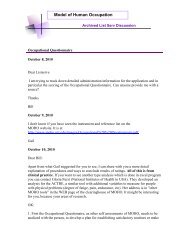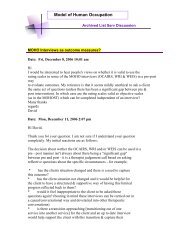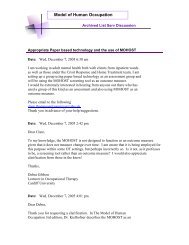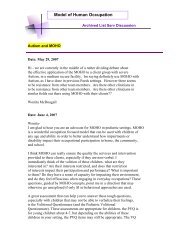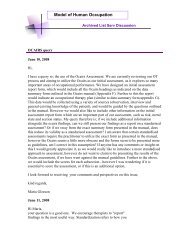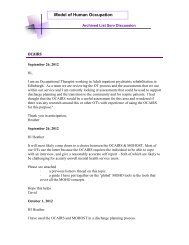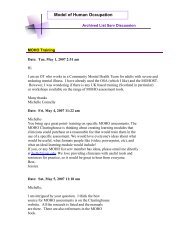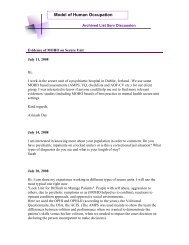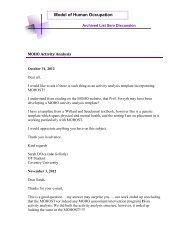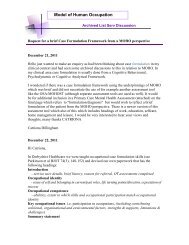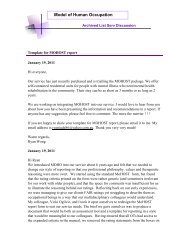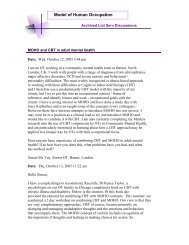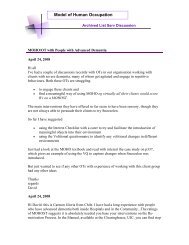Brief Definition of MOHO model
Brief Definition of MOHO model
Brief Definition of MOHO model
Create successful ePaper yourself
Turn your PDF publications into a flip-book with our unique Google optimized e-Paper software.
Long definition: <strong>MOHO</strong> provides a framework (or <strong>model</strong>) for occupational therapist to<br />
understand how to use daily activities therapeutically to support people’s health. It seeks<br />
to explain how meaningful daily activities are motivated, patterned, and performed.<br />
First motivation….<strong>MOHO</strong> supports an understanding <strong>of</strong> how people are motivated and<br />
make choices for doing the activities that fill their lives. To explain human motives for<br />
daily activities, <strong>MOHO</strong> answers critical questions e.g., what accounts for the individual<br />
differences in what people want and choose to do?, why is one bored by an activity that<br />
another enjoys?, why does one person find valuable what another considers a waste <strong>of</strong><br />
time?<br />
Secondly, <strong>MOHO</strong> supports an understanding <strong>of</strong> why everyday life is made up <strong>of</strong><br />
recurrent patterns <strong>of</strong> behaviour in familiar physical and social environments. People<br />
behave in similar ways over and over again, they follow similar patterns <strong>of</strong> time use, and<br />
they do things in pretty much the same way they did them before. A great deal <strong>of</strong> human<br />
life simply follows a routine pattern <strong>of</strong> daily activities. These routine patterns support the<br />
fulfilment <strong>of</strong> role responsibilities….being mothers, friends, workers, sons….…giving us<br />
a sense <strong>of</strong> who we are.<br />
Finally, <strong>MOHO</strong> supports an understanding <strong>of</strong> how people perform daily activities.<br />
Whether it is lifting food to one's mouth or playing first violin in an orchestra, humans<br />
demonstrate fine and coordinated movements when they do things. When performing<br />
daily activities, people also anticipate, plan, observe what happens, make adjustments and<br />
decide what to do next. Whether it is getting one's clothes washed, folded, and stored<br />
away in the closet or designing & assembling a car, people show an uncanny ability to<br />
figure out how to get something done. People also participate and communicate with<br />
others. From simple conversation to participation in a scientific discussion - the ability to<br />
coordinate action and share information is part <strong>of</strong> engaging in everyday activity.<br />
<strong>MOHO</strong>, therefore, explains how daily activity is motivated, organized into everyday life<br />
patterns, and performed in the context <strong>of</strong> the environment.<br />
<strong>MOHO</strong> also provides support for occupational therapist to use this theory in practice.<br />
There are assessments (which support therapists to ask questions to understand people’s<br />
lack <strong>of</strong> engagement in daily activity) & intervention protocols (which support therapist,<br />
use daily activities therapeutically to impact health).<br />
Hope this is helpful,<br />
Warm wishes,<br />
Pr<strong>of</strong> Forsyth<br />
October 19, 2010<br />
Leena, this is what I use.



